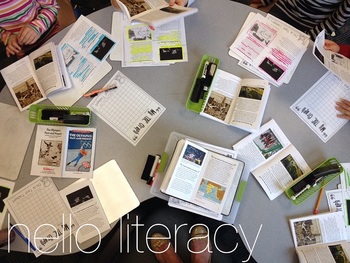Text Based Evidence Graph: A Close Reading Behavior & Motivation Tool
- PDF
What educators are saying
Description
My BLOG POST about how to use this graph with your students. And, a follow-up blog post HERE.
By now, we all know the Common Core emphasis on TB Q&A with TBE (text based questions and answers with text based evidence), but if you were at all like me, I couldn't get the kids to DO IT, until THIS, My TBE Graph. While I was racking my brain trying to figure how to get kids to speak and show where in the text they were finding the answer, with words and phrases FROM the text...it occurred to me that there really is only two things this generation of students are motivated by, 1)instant gratification...seeing results right now; and 2)accumulation... stuff, bananas, mushrooms, colored boxes. As students answer (and eventually ask) your text-based questions during guided reading, they must (using whiteboards) write the answer with "quotation marks" and they must document where in the text the answer is found. Using the checkbric (checklist+rubric) listed at the bottom of the TBE Graph (not shown in the preview) student fill in the graph, right then and there. The object is to fill up the sheet, that's it, and IT alone is highly motivating. If just one time they forget to do something in the checkbric, that is the LAST time they forget. I know I do not give you a lot to go on in the product image or previews, but if you are a Hello Literacy follower, or even if you're not, I promise you will not be disappointed in this simple yet powerful tool to get kids asking and answering text based questions WITH text-based evidence and proof. It's AMAZING! When my principal saw it in action, he asked me for it and immediately emailed it to the entire staff with a note that I would facilitating their next PLT to explain it. I really didn't mind because it seriously works! I will be writing a blog post about it in the next few days, so look for that soon. This graph works especially well if your students (like mine) answer higher level questions better than lower level questions on standardized tests, because this strategy forces them to locate and prove TBE answers to lots of Right-There text based questions.
What's included in this product is:
1 - My TBE Graph (another version called Grid, another version called Bookmark)
1 - Explanation of how it works with a video link
Thank You!
Jen Jones - Hello Literacy
Follow Hello Literacy on Facebook
Follow Hello Literacy on Instagram
Follow Hello Literacy on Twitter
Follow Hello Literacy on Pinterest
Follow Hello Literacy on Slideshare
Follow Hello Literacy on LinkedIn
© 2014, Hello Literacy, Inc. | All Rights Reserved. My TBE {Text Based Evidence} Graph: A Common Core Close Reading Motivation Tool. Permission is granted to original purchasers to reproduce material as designated only for their own classroom/home-school use. No other part of this work may be reproduced in any form or by any electronic or mechanical means including information storage and retrieval systems without permission in writing from the publisher, except by a reviewer, who may quote brief passages in a review. Permission is also granted for any purchaser to blog about the relevancy and/or usefulness of this product from their own personal classroom use if links back to this product are included.





